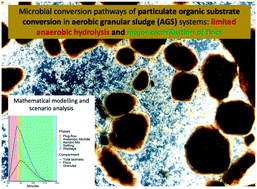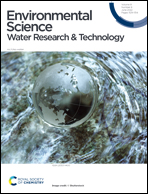Microbial conversion pathways of particulate organic substrate conversion in aerobic granular sludge systems: limited anaerobic conversion and the essential role of flocs†
Abstract
Particulate organic substrate (XB) represents the major fraction of organic substrate in low-strength municipal wastewater (MWW) but its hydrolysis, conversion and utilisation in aerobic granular sludge (AGS) are not well understood. We systematically analysed through modelling the microbial conversion pathways of XB in AGS systems operated as sequencing batch reactors and treating municipal wastewater. Based on our current understanding of AGS systems, we developed an AGS model in Sumo® to better understand (1) during which phases of the SBR cycle (anaerobic plug-flow feeding or aerobic fully-mixed conditions), (2) by what biomass fraction (granules or flocs) and (3) via which microbial processes XB is converted into soluble organic substrate (SB) and volatile fatty acids (SVFA) and further utilised. The validity of all our results was evaluated by assessing the sensitivity of findings on the biomass distribution (floc fraction) (SCENARIO #1), SBR cycle (SCENARIO #2), and biofilm properties (SCENARIO #3). Our results indicate that only 20% of influent XB was hydrolysed and 11% of influent XB was then used for internal carbon-storage during 90 min anaerobic plug-flow feeding. The major fraction of influent XB (80%) leaked into the aerobic SBR phase, where XB was then hydrolysed and oxidised aerobically by ordinary heterotrophic organisms (OHOs). Under aerobic fully-mixed conditions, the flocs successfully competed for XB with the granules. Aerobic XB hydrolysis and its further utilisation by OHOs occurred mainly in flocs despite their minor biomass fraction (13% of total suspended solids), preventing excessive OHO growth on granules and demonstrating that flocs are beneficial for AGS systems treating MWW. Also, the model allowed us to better understand that the SBR sequence can be optimised to make better use of XB under anaerobic conditions and to reduce the leakage of XB to aerobic conditions. The introduction of a 60 min anaerobic idle phase after a 60 min plug-flow feeding phase almost doubled the anaerobic XB hydrolysis and internal carbon-storage by phosphorus and glycogen accumulating organisms (PAOs and GAOs), respectively, compared to 90 min plug-flow feeding. Nonetheless, most influent XB was still utilised by OHOs during the aerobic SBR phase.



 Please wait while we load your content...
Please wait while we load your content...